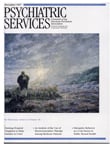Symptoms Predicting Inpatient Service Use Among Patients With Bipolar Affective Disorder
Abstract
OBJECTIVE: Symptoms that were risk factors for hospital readmission among psychiatric inpatients diagnosed as having bipolar affective disorder were evaluated. METHODS: Subjects were 100 persons consecutively admitted to a psychiatric inpatient unit at a university-affiliated hospital who met Research Diagnostic Criteria for bipolar I or II disorder or schizoaffective disorder, manic type. Patients were assessed using the Schedule for Affective Disorders and Schizophrenia—Lifetime Version (SADS-L) and the Brief Psychiatric Rating Scale (BPRS) within one week of discharge, and their hospitalization status was documented by monthly phone contacts over a period of 15 months. RESULTS: Twenty-four patients (24 percent) were rehospitalized within six months of discharge, and 44 (44 percent) were readmitted within 15 months. Survival analysis using the Cox proportional hazard regression model demonstrated that patients with high scores on a BPRS-derived mania factor were at significantly decreased risk of rehospitalization, whereas those scoring high on a factor consistent with neurovegetative depression were at significantly increased risk. A greater number of previous psychiatric admissions and younger age were also associated with significantly increased risk of rehospitalization. CONCLUSIONS: The findings suggest that patients with bipolar disorder presenting with a depressive episode characterized by prominent neurovegetative features should be treated more aggressively with both pharmacotherapy and intensive outpatient services to reduce the relatively high risk of rehospitalization that appears to be associated with this type of depression.



